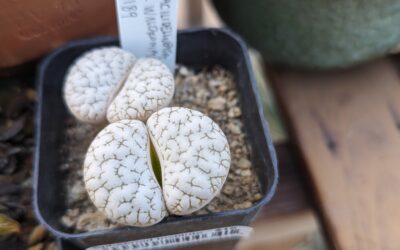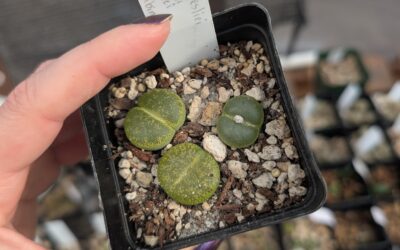Echeveria Bambino! A cute little hybrid I picked up from a Hawaiian importer that has some absolutely beautiful plants. This one was a hybrid I picked up because I thought, originally, it’d be a fairly pale and powdery hybrid (I was going through a distinct farina phase at the time). These are pretty distinct hybrid that gets quite large with time, and has very pretty little sprays of pink blooms.
As per the Crassulaceae network, this hybrid began as a seedling found under a Mexican Giant that was open pollinated in an Australian grower’s garden, so the exact parentage is unknown. The cute little pink blooms show influence of Echeveria laui, but whether it’s a pure colorata x laui hybrid, or if the laui side was a hybrid as well.
Rosettes on these reach about 8″ across, with the blooms arriving in spring and summer on stalks up to 16″ long. I only have the one specimen, so this will be a care diary through the acclimation and growth into its larger form. This particular plant was originally a Korean import; I’m not sure if anyone in the US is actively trying to cultivate these in large enough quantities for resale, but it’s certainly possible. It’s far more common to see Echeveria Bambinos sold from overseas nurseries and imported to the US, though.
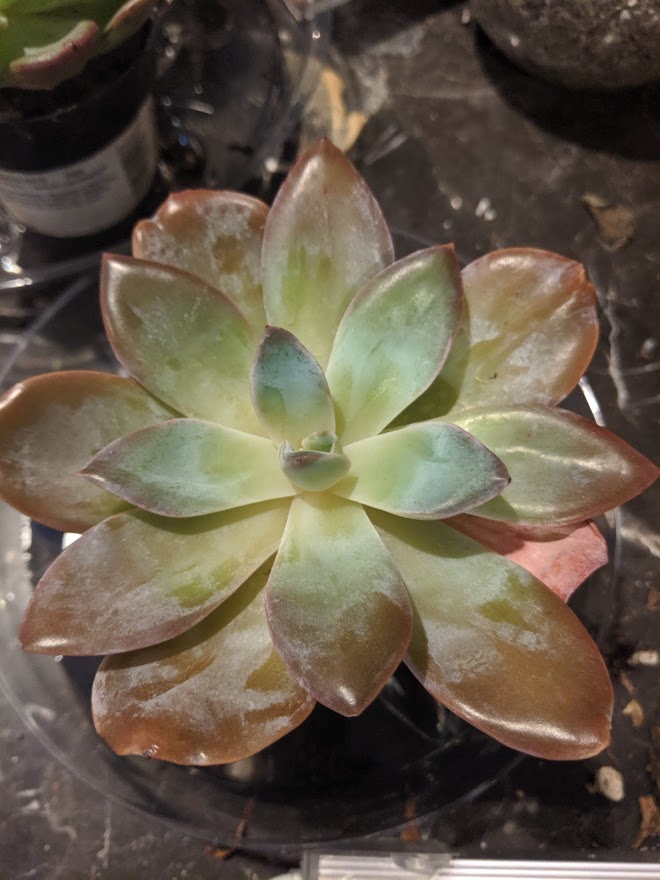
This is the Bambino when I first unpacked it in October 2019. It had the red tips from stress, and was stretching a bit in the center due to the time in transit. As with most imports, it was just the top cut of the plant, with a portion of exposed stem ready to nestle into soil to get rooted. Because of the powdery farina, I planned on rooting it over a pot about as big around as the plant itself, if not slightly bigger in diameter, so that I could leave it there for a while without disturbing it.
The better thing to do is get it going in a pot that is fairly tiny to ensure the soil doesn’t stay soggy for too long, which stunts the growth of new roots.
Here it is potted and generally acclimated for outdoors, as of November 2019. You can see that the pale, sickly green color has ‘hardened’ off to a more opaque shade, and the red color has faded considerably compared to when it was first imported.
Many of the larger outer leaves are slowly shriveling, which is to be expected, as there’s no roots to support the plant. Instead, that energy is being used to create those roots, which you can’t see below it.
I set it up with a blend of soil that was relatively high in pumice to ensure good drainage and fast drying. I mixed the soil, filled the pot, and then placed a solid top dressing of pumice over it. To place the plant to get established, I used a finger to gently push aside some pumice, and buried the stem so it was touching the soil. Otherwise, it rests directly on the rocks.
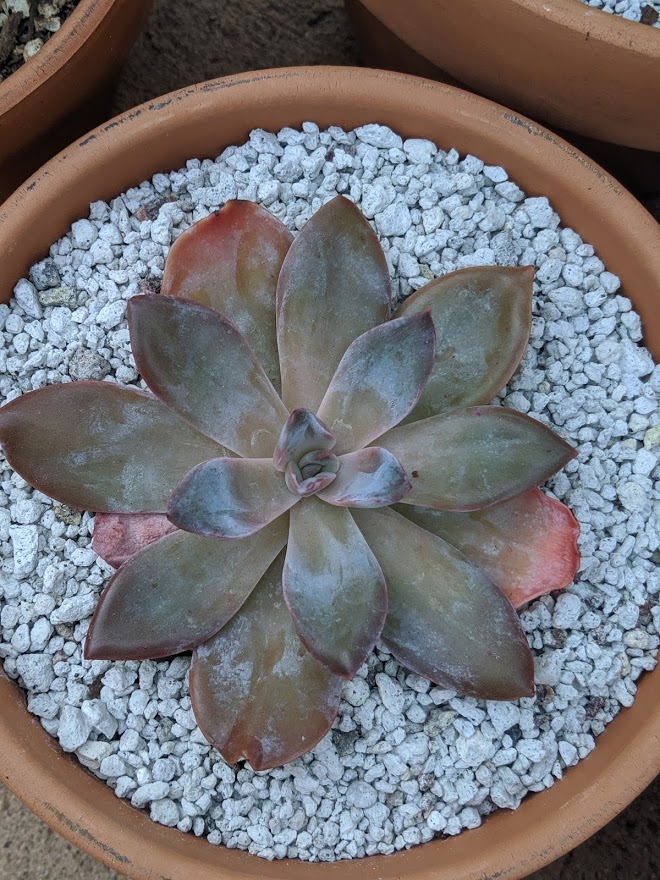
I took a few weeks getting the Bambino acclimated to sunlight enough to be outdoors, and even in November, it was in a spot that only received a few hours of morning light, and filtered sunlight or outright shade the rest of the day. It also was exposed to cool winter temperatures, as the November nights dropped to the 50s and 60s regularly. Because it was on such a well draining mix, I didn’t worry too much about watering it – I would haphazardly spray it with the hose when I watered the shelves it was next to, but didn’t soak it or go out of my way to water it more often. It was watered lightly every one or two weeks at best.
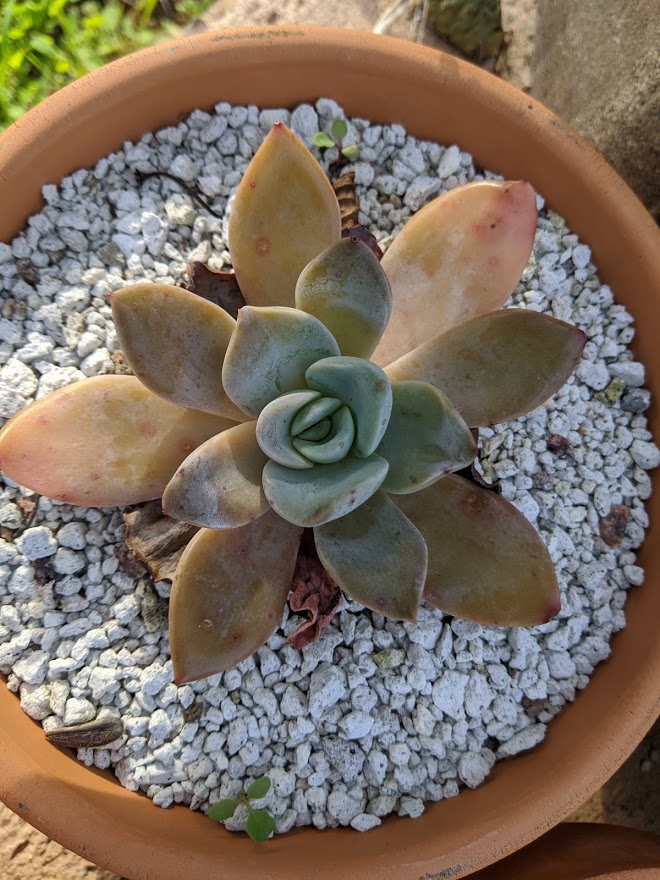
Echeveria Bambino as of January 2020 – after a few months outdoors with plenty of light, it’s producing thick, chubby new growth at the center.
The widest outer leaves have all mostly been absorbed or shriveled, and the red coloration is almost entirely gone. The new growth in the center is the delightfully pale powdery blue/green color I was hoping for, and the chubby look was quite cute.
January and February are our coldest months here, as well as our wettest, so around this time I really cut back significantly on watering. I might have watered once or twice for January and February last year; I know this year (2021) I have watered the outdoor succulents a grand total of 3 times since the start of the new year.
Here’s the growth update for March of 2020 – plenty of rain had been happening last spring (as you can see by the amount of green grass behind it), and the pumice on top is still damp in this photo.
By this time, however, the Bambino was well rooted and clearly thriving well enough to start producing a bloom stalk. The chubby new growth leaves have grown into more mature looking, large and flat leaves, and a few of the original import leaves are still holding on at the bottom layer.
You can see some disruptions in the farina from my fingers, rain, and general debris blowing around the yard. My thumb helps provide some size reference as well; the pot that it’s in is a 6″ terra cotta azalea pot. I prefer the azalea pots due to their squatter shape.
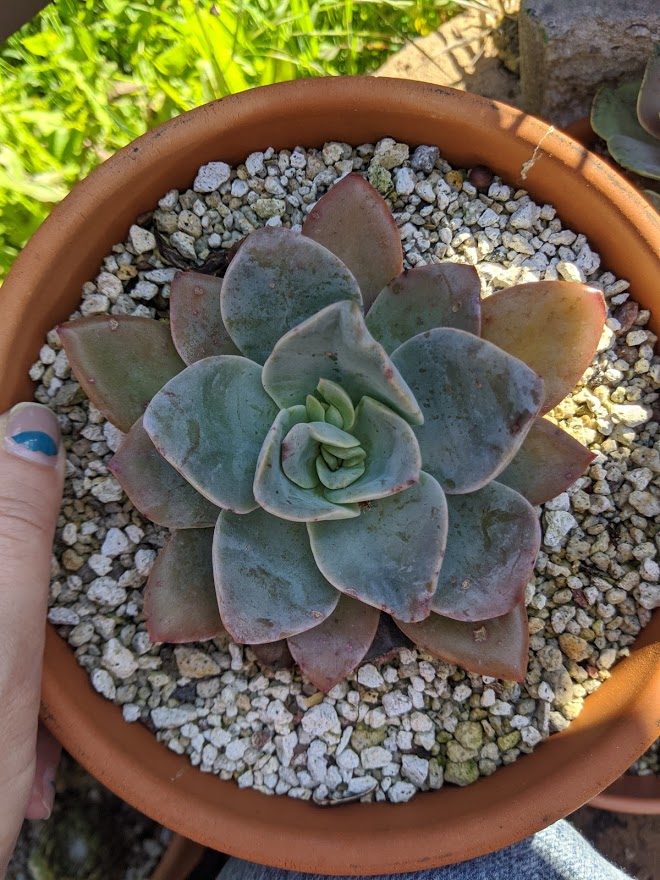
Sadly, despite the Bambino preparing a bloom stalk, I couldn’t find any photos in my camera reel of the bloom. It’s hard to get good photos of bloom stalks, as they are so much taller than the plant and make finding a good depth of field for the focus super challenging. With the heat of summer and what I can only assume was a tall, ungainly bloom stalk, I don’t have photos of the bambino again until fall rolls around.
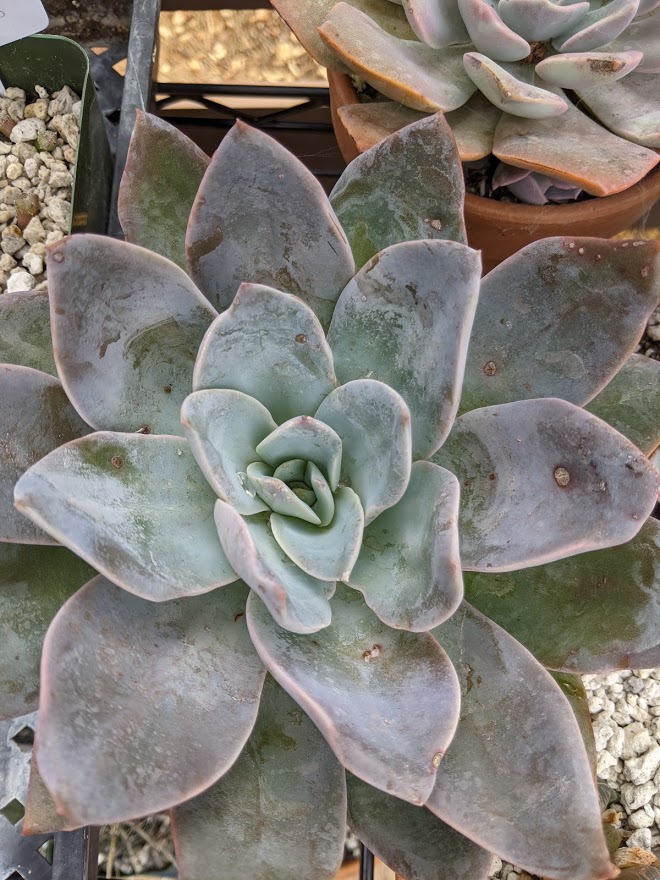
And the beautiful Bambino in September 2020! It spent the summer getting big and gorgeous, and was rapidly getting too big for the pot. You can’t even see the 6″ pot it’s in due to just how big the leaves have spread.
There are some damage spots on outer leaves, but that’s a fact of life if you have your plants outdoors and unprotected.
As the Bambino has grown larger, the outer leaves have taken on a more lavender hue, with the center of the plant being the frosty blue.
You can see a bit of the farina dusted off a few outer leaves at the top edge – I was brushing off my ariocarpus and decided to try using the paintbrush to knock off some dandelion seeds from the Bambino. This was a bad idea. The farina won’t return, it’ll just produce new growth.
By December 2020, I’d potted it up into what I hope will be more of a long term/lifetime pot – this is an 8″ bowl-style pot, so it’s not too deep but will give the Bambino space to stretch and hopefully pup.
In the process of dusting off the roots and preparing it for the new pot, I discovered it had fairly flimsy roots compared to most of the other Echeveria hybrids I’ve had in pots for a long period of time. The reason for this could be the amount of pumice in the soil, water being plentiful all through the growing season, not enough water when it was hot, or just the hybrid itself not being a particularly root-happy hybrid. I’m not sure; my sample size is one plant!
This photo shows the Bambino in more sun, and by this time, I had it on our patio table for nearly full sun most of the day. This led to sun stress turning it more orange on the outer leaves, rather than lavender.
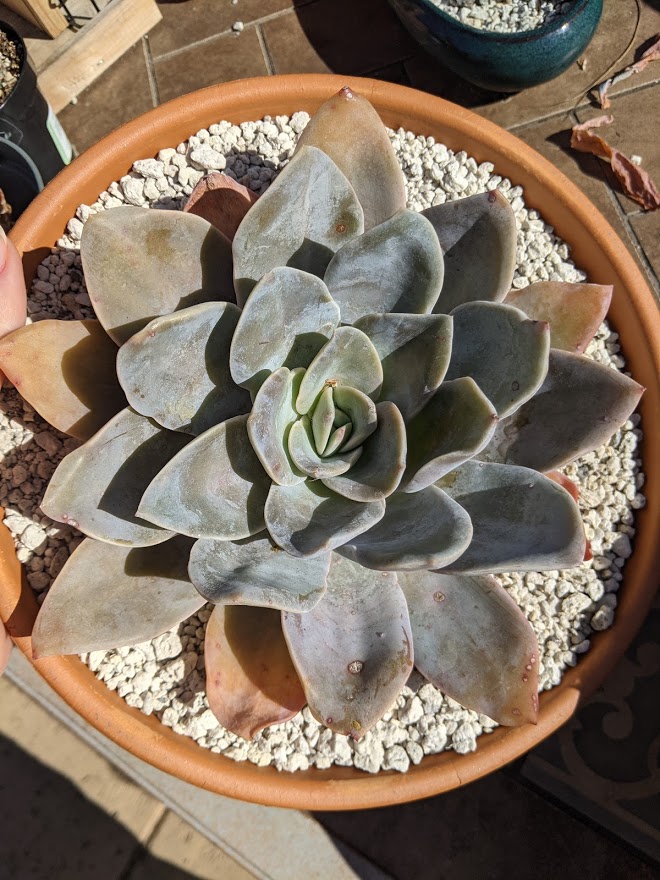
When I potted it into the new pot, as a precaution, I also applied some Bonide pellets to the soil underneath. The existing and soon to develop roots would absorb the systemic pesticide, and help protect the plant during a time of stress (transplanting). As it wasn’t likely to bloom until March or April, and I’d applied the systemic in November, that was enough time for the systemic pesticide to protect the plant and then wear off before impacting our beneficial pollinators. The farina on this particular hybrid makes applying any sort of topical pesticide extremely undesirable, as a spray or oil will rub off the farina coating. The coating doesn’t come back once it’s lost, so if a topical pesticide is needed, it’ll be visible until the echeveria has replaced the growth.
The Bambino settled in, was producing new growth, and looking great after being repotted…until our recent hail storm. As it was out on the patio table, it was exposed to the full force of the storm, and was pelted heavily by small, pellet-sized hail chunks. We had hail in bursts throughout an afternoon, and then again at night, which froze in chunks all around the property, in pots, the crowns of several tree aloes, and all along our walkways. Poor little Bambino was out for all of it, and has survived and continued to thrive…just with some freckles.
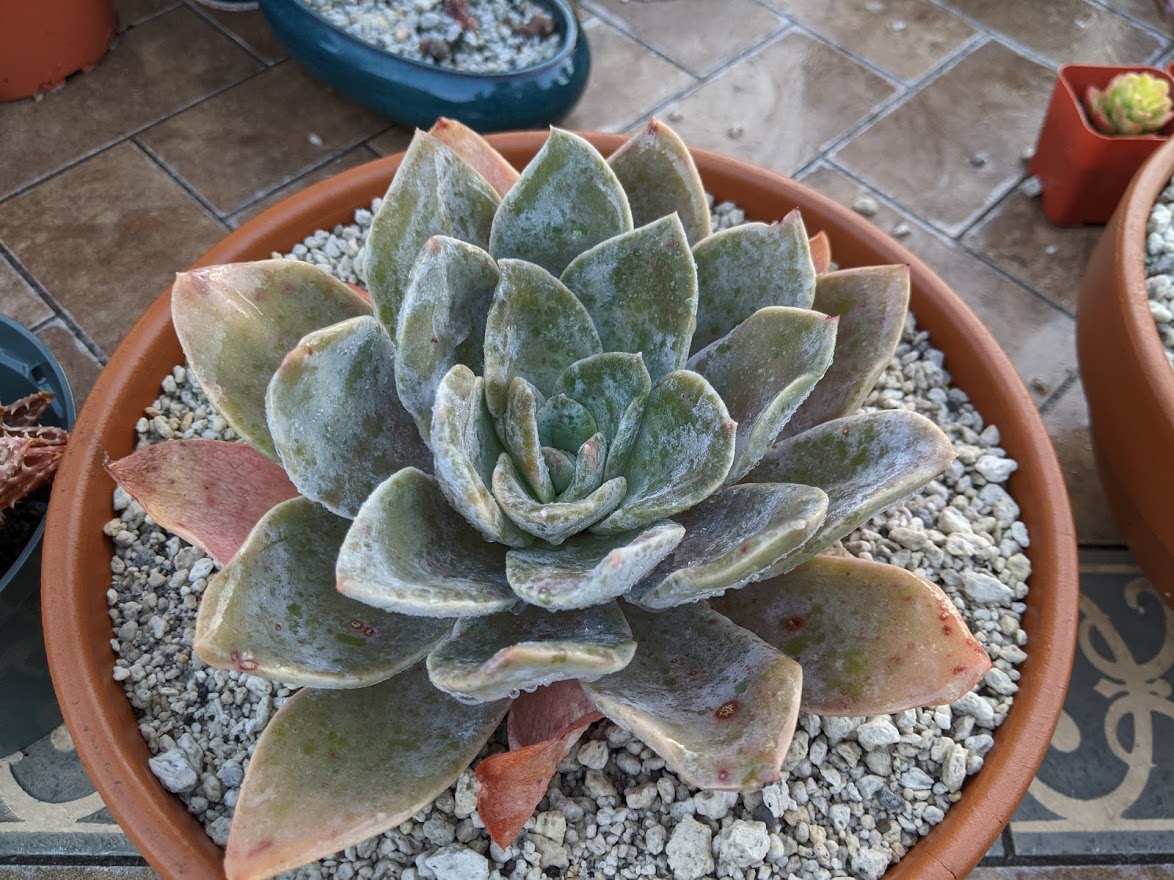
This is from the morning after. You can see that it’s wet, that there’s some darker wet looking spots, but the Echeveria looks…mostly unscathed. I was tentatively hopeful the damage wouldn’t be too bad, but I wasn’t all that optimistic. We’d had a hailstorm here in 2018 and I saw the damage that did to my succulents at that time. Funny thing with hail is that the damage can take a few days to really manifest and be visible; the plants need some time to heal from the bruising and eventually develop scars.
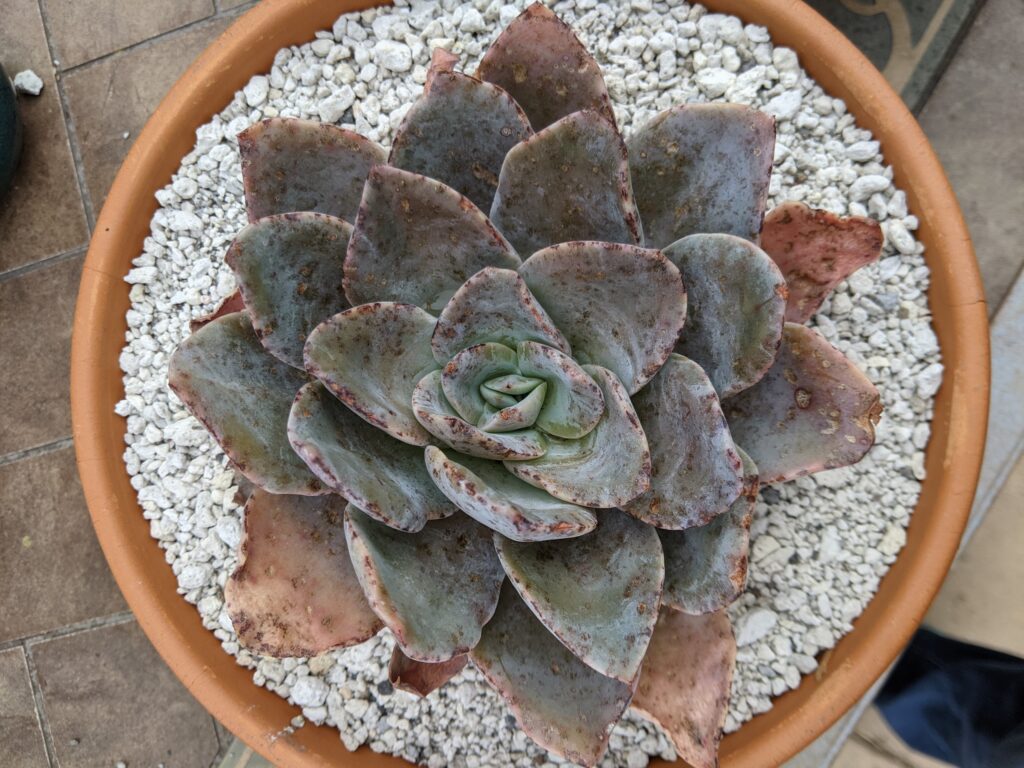
And here is the Bambino a couple weeks after the hail storm. Lots of spotting, but you can actually spot some repeat of the growth pattern from the previous year. Chunky new baby leaves in the center with darker, almost red-hued outer leaves (our nights were consistently colder the last few weeks).
I’m sure by the time spring is in full swing, and it’s produced a new bloom stalk, that it’ll be hard to tell that there was even hail damage. Many of my echeverias with damage are rapidly producing new growth, and show clear lines between hail damaged leaves and the new, pristine growth.
The Echeveria Bambino is definitely a gorgeous plant, and I am hopeful that the rest of this year will prove a little less dramatic in terms of growth conditions. With some protection from the elements, Echeveria Bambino can get quite powdery and pale, and that’s my aim for this upcoming growing season.

